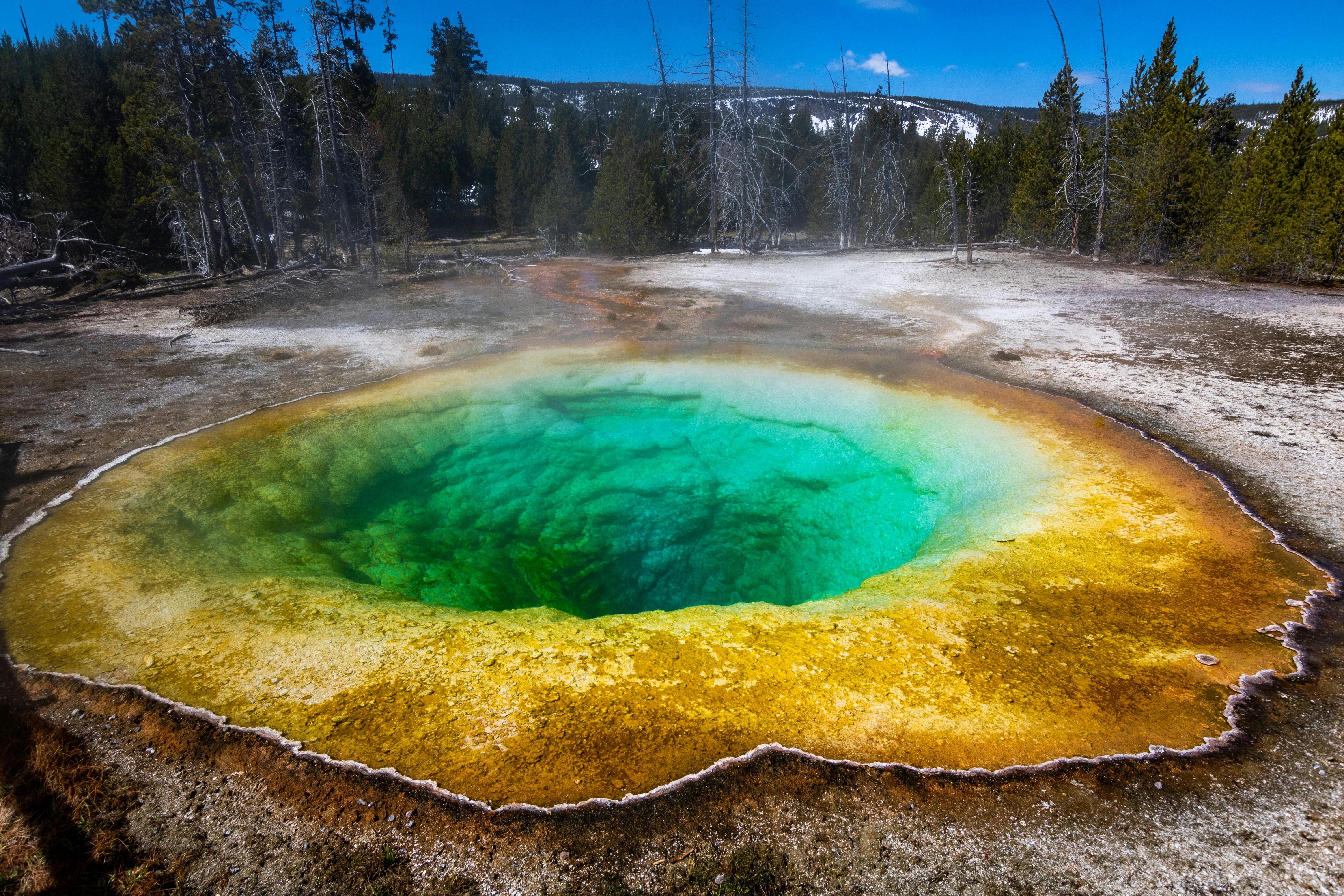
Ask ten Yellowstone lovers “winter or summer?” and you’ll hear ten confident answers—each one right for the traveler behind it. This guide compares Yellowstone in winter vs summer—weather, access, wildlife, activities, costs, crowds, and photography—so you can pick the season that actually fits how you travel.
Yellowstone in Summer
Vibe: Long days, open roads, and the park running at full steam. Wildflowers in June–July, thundering waterfalls from snowmelt, and warm evenings that stretch into pastel sunsets.
Weather & Access
- Typical highs: 18–27°C (65–80°F) in valleys; cooler at elevation.
- All main roads and services are generally open late spring through early fall.
- Afternoon storms are common—pack a light shell.
What You Can Do
- Hike virtually everywhere—see our Best Hikes in Yellowstone.
- Tour geyser basins (Old Faithful, Grand Prismatic, Norris).
- Boating & lakeside walks at Yellowstone Lake.
- Wildlife drives in Lamar & Hayden Valleys.
Wildlife & Photography
Calves and cubs appear early summer; big bison herds dominate meadows by July–August. Midday heat pushes animals to shade, so sunrise and dusk are prime. Photographers should plan for harsh midday contrast—use backlit steam, forest shade, or shoot long lenses across valleys.
Pros
- Maximum trail and road access; family friendly.
- Longest daylight hours for big itineraries.
- Predictable services (lodging, dining, ranger programs).
Cons
- Crowds and higher prices (lodging sells out months ahead).
- Midday heat haze for telephoto wildlife shots.
- Parking pressure at iconic stops—arrive early.
Yellowstone in Winter
Vibe: Quiet, crystalline days; plumes of steam rising into blue air; snow muffling the usual summer bustle. Access is limited—but what you do see feels like a private showing.
Weather & Access
- Typical highs: −12 to −1°C (10–30°F). Nights can be much colder.
- Most park roads close to personal vehicles; snowcoach/snowmobile access to key areas (Old Faithful, Canyon) from gateway communities.
- Dress in breathable layers; protect hands/feet and carry spare batteries.
What You Can Do
- Guided snowcoach or snowmobile tours to geyser basins and the Grand Canyon of the Yellowstone.
- Cross-country skiing & snowshoeing on designated routes.
- Wildlife viewing (wolves are easier to spot against snow).
- Winter photography of steam, hoarfrost, and low-angle light.
Wildlife & Photography
With fewer visitors and white backdrops, animals stand out. Elk and bison gather in thermal areas; wolf watching peaks on frigid mornings. Photographers should prepare for battery drain and handle condensation when moving indoors/outdoors.
Pros
- Crowd-free serenity and unique steam-on-snow scenes.
- High wildlife visibility (tracks and contrast).
- Memorable guided experiences; excellent night skies.
Cons
- Limited access; tours required for many areas.
- Short daylight, extreme cold, weather-related cancellations.
- Some lodgings/services closed or on reduced hours.
Winter vs Summer: Side-by-Side Comparison
| Factor | Summer | Winter |
|---|---|---|
| Road & Trail Access | Nearly all roads/trails open; easy self-drive | Most roads closed; snowcoach/snowmobile tours |
| Crowds | High (June–Aug); arrive early | Very low; peaceful viewpoints |
| Costs | Lodging & tours peak pricing | Fewer options; guided tours add cost |
| Wildlife | Abundant but dispersed; best at dawn/dusk | High visibility; wolves easier to spot |
| Photography | Harsh midday light; long golden hours | Low-angle light; dramatic steam & snow |
| Activities | Hiking, boating, full basin touring | Skiing, snowshoeing, guided basin access |
| Weather Comfort | Mild to warm; afternoon storms | Cold to extreme cold; short days |
Tip: If you’re flexible, shoulder months (June & September) offer many summer perks with fewer crowds.
Which Season Fits You Best?
Families & First-Timers
Choose summer for simpler logistics, wide-open access, and kid-friendly boardwalks. Book lodging early and plan a midday break to avoid crowd peaks.
Hikers & Road-trippers
Summer wins for trail variety and self-drive freedom. Early starts (before 8 a.m.) transform the experience.
Wildlife Watchers
It’s a tie: summer has newborns and big herds; winter makes predators easier to spot. If wolves are your dream, lean winter.
Photographers
Winter offers clean backgrounds and steam drama; summer gives alpenglow hikes and Milky Way nights. Either way, plan for sunrise/sunset light.
Adventure Seekers
Winter brings unique travel modes (snowcoach/snowmobile) and quiet trails on skis or snowshoes.
Planning Tips, Costs & Safety
Reservations & Budget
- Book lodging months ahead for summer. Consider gateway towns (West Yellowstone, Gardiner, Cody).
- Winter budgets often shift from lodging to guided transport—price tours first, then add nights.
- Pack snacks and refillable bottles to reduce food costs and time in lines.
Packing & Safety
- Summer: Layers, rain shell, sun protection, plenty of water.
- Winter: Insulating layers, windproof outerwear, warm boots, spare gloves, chemical warmers.
- Carry bear spray (know how to use it). Stay on boardwalks in thermal areas.
- Keep safe distances: 25 yards from most wildlife; 100 yards from bears & wolves.
FAQ: Yellowstone Winter vs Summer
Can I drive my own car in winter?
Most park roads close to personal vehicles in winter. Access popular areas via guided snowcoach/snowmobile from gateway towns; the North Entrance to Mammoth/Gardiner typically has the most driveable access.
Is summer too crowded to enjoy?
It can be busy, but smart timing works wonders: enter before 8 a.m., visit popular basins early/late, and save scenic drives for midday. Consider June or September for lighter crowds.
What’s the cheapest season to visit?
Winter can be cheaper for lodging but may require paid tours for access. Summer has more availability outside park gates if you book early and stay flexible.
Which season is better for photography?
Winter offers graphic, minimalist scenes and easier predator visibility; summer provides wildflowers, long blue hours, and Milky Way opportunities. Both reward sunrise/sunset shooting.
Is Yellowstone suitable for kids in winter?
Yes, with planning: choose short tours, dress warmly, and schedule frequent warm-up breaks. Summer remains simpler for most families.
Next reads: Best Hikes in Yellowstone • Top Attractions • Wildlife & Photography